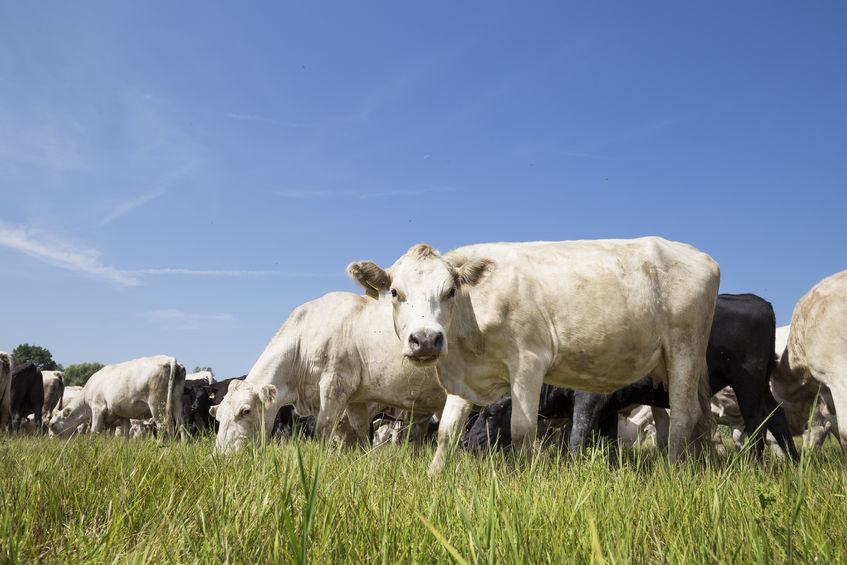
Major beef processor plans to reduce carcase weights from October are offering opportunities for the Charolais breed as finishers look for adaptable animals that meet changing consumer demands.
The weight drop of between 20kgs and 40kgs per carcass depending on buyer, also brings with it new penalties for heavier beasts which, when coupled to a six-year low in pricing, means bigger challenges that this particular breed is well set to meet.
The industry’s belief is that processors are acting on pressure from the retail trade, who want smaller prime cuts to meet declining consumer demand for red meat.
“Finishers need an animal that is a great food converter and therefore finishes quickly, so they can finish more animals in order to make money,” says Charolais chief executive Peter Phythian.
“This is where the modern Charolais fits so well. We see this as a big opportunity for the breed as finishers are going to be looking for animals they can turn around more quickly.”
Norman Gammie farms in partnership with his brothers at Mains of Gallery in Montrose and, as well as running 400 sucklers, buys in between 1500 and 2000 stores at around 500kgs to finish over 120 days.
“We would have got to 750kgs with the steers, but now we’ll have to make sure we don’t go above 700kgs,” he explains.
“With a killing out percentage of between 54% and 56% we’re going to have to monitor cattle very carefully.
“This will mean better than ever management and more regular weighing.”
He says heifers don’t pose as much of a problem, as they usually finish below 400kgs, but that the problem lies with the bullocks.
A 20kg drop in the weight limit at £3.50kg means a loss of gross income of £70 per beast.
“We’re very committed to Charolais animals, and we’ll have to select more carefully in the future.
“We will be looking for lighter store animals, and they are available, as we need a 150-200kg liveweight gain to get a margin.
“I don’t believe we’ll change breed, the Charolais is well suited to this job, we’ll just select more carefully and manage them more closely.”
He pointed out that he would have to look at turning over more animals to stay in profit, and said his longer-term concern was that the weights would keep decreasing as there’s already a premium available for animals under 380kgs. This may mean changes in management in the future.
Willie Barr, who farms 1000 acres of grass and cereals at Halhill Farm, Cupar, Fife, believes that entering the world market, post Brexit, could mean a big boost for the smaller carcasses that appear to meet current consumer demand.
He buys 250 cattle, mainly Charolais and Charolais crosses, to fatten each October, and also says that this year he will be looking for the smaller framed animals.
“The Charolais offers a great return on investment because of their ability to turn food into meat, quickly, and the breed has moved a lot over the past few years.
“I don’t see me changing away from the breed, it will be more about selecting better and managing better.”
He said the bigger animals were worth £4/kg and at their heaviest were returning around £2000 a head.
Now, with the move to lighter carcass weights and lower beef prices, he is looking at a return of between £1300 and £1400 a head.
“The only way to get around this is to fatten more cattle – I will probably buy 300 rather than 250 this autumn.
“We’ll also look at buying more in the spring, and maybe we’ll buy a bit later to fit into our system better.”
Latest information by AbacusBio shows the breed also has a lower carbon footprint as it gains weight quicker and is more suited to future changes indicated in the Agriculture Bill, which is likely to reduce the slaughter age from 12 months to 10 months.
“We’re finding it harder to find the sort of animal we want, but we’re committed to the Charolais because of their weight gain, and ability to put on weight fast, even when at grass. They’re easy to handle and very popular in the markets here.”
He says penalties for cattle over 400kgs come in with a 5p/kg penalty over 400kgs, and a 10p/penalty over 410kgs.
“This could get very costly, so we’re going to have to be very careful with our management. How we keep our cattle may have to change.”
